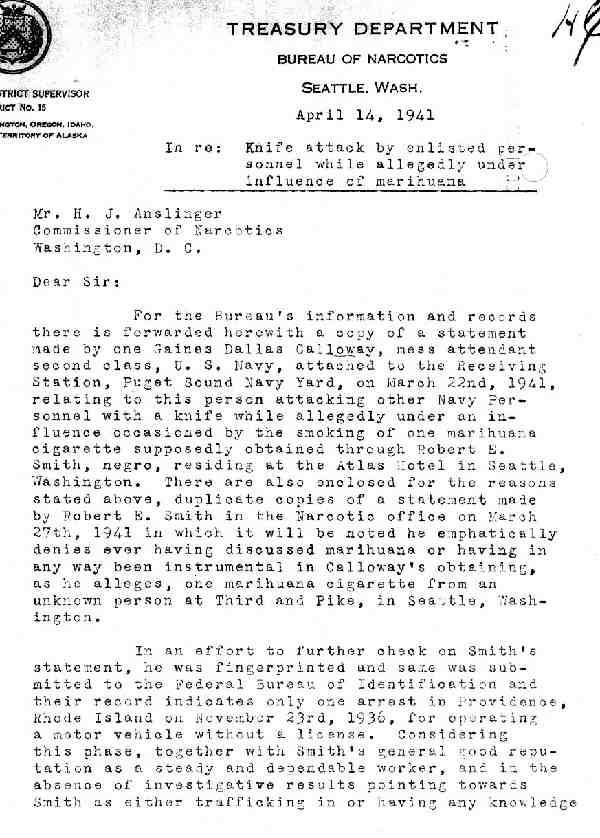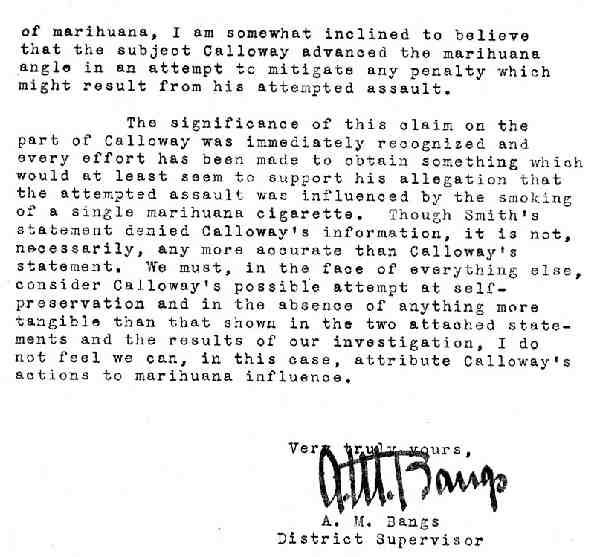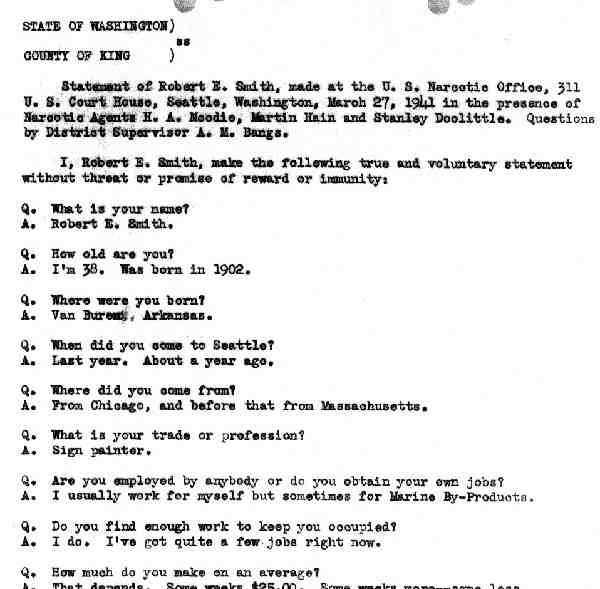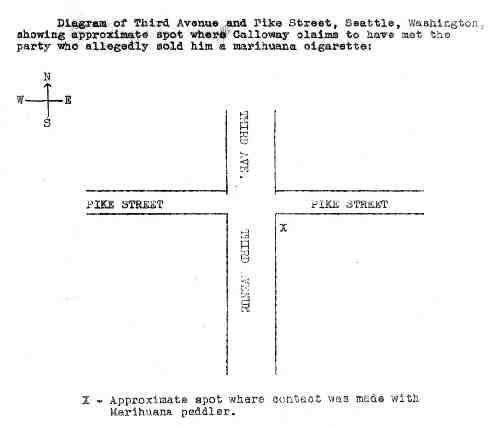
|
|

|
|---|
DURING THE REEFER MADNESS ERA
THE GAINES DALLAS CALLOWAY CASE


Treasury Department
Bureau of Narcotics
Seattle, Wash.
April 14, 1941
Office of District Supervisor
District No. 15
States of Washington, Oregon, Idaho,
Montana, and Territory of Alaska
In re: Knife attack by enlisted personnel while allegedly under influence of marihuana
Mr. H.J. Anslinger
Commissioner of Narcotics
Washington, D.C.
Dear Sir:
For the Bureau’s information and records there is forwarded herewith a copy of a statement made by one Gaines Dallas Calloway, mess attendant second class, U.S. Navy, attached to the Receiving Station, Puget Sound Navy Yard, on March 22nd, 1941, relating to this person attacking other Navy Personnel with a knife while allegedly under an influence occasioned by the smoking of one marihuana cigarette supposedly obtained through Robert E. Smith, Negro, residing at the Atlas Hotel in Seattle, Washington. There are also enclosed for the reasons stated above, duplicated copies of a statement made by Robert E. Smith in the Narcotic office on March 27th, 1941 in which it will be noted he emphatically denies ever having discussed marihuana or having in any way been instrumental in Calloway’s obtaining, as he alleges, one marihuana cigarette from an unknown person at Third and Pike, in Seattle, Washington.
In an effort to further check on Smith’s statement, he was fingerprinted and same was submitted to the Federal Bureau of Identification and their record indicates only one arrest in Providence, Rhode Island on November 23rd, 1936, for operating this phase, together with Smith’s general good reputation as a steady and dependable worker, and in the absence of investigative results pointing towards Smith as either trafficking in or having any knowledge (1)
Page 2
Of marihuana, I am somewhat inclined to believe that the subject Calloway advanced the marihuana angle in an attempt to mitigate any penalty which might result from his attempted assault.
The significance of this claim on the part of Calloway was immediately recognized and every effort has been made to obtain something which would at least seem to support his allegation that the attempted assault was influenced by the smoking of a single marihuana cigarette. Through Smith’s statement denied Calloway’s information, it is not, necessarily, any more accurate than Calloway’s statement. We must, in the face of everything else, consider Calloway’s possible attempt at self-preservation and in the absence of anything more tangible than that shown in the two attached statements and the results of our investigation. I do not feel we can, in this case, attribute Calloway’s actions to marihuana influence.
Very truly yours,
A.M. Bangs
District Supervisor

March 22, 1941.
Transcript of testimony taken during questioning of Gaines Calloway, mess attendant second class, U.S. Navy, attached to Receiving Station, Puget Sound Navy Yard, by Mr. H.M. Moodie, Federal Narcotic Service.
Q. Where did you get the marihuana cigarette?
A. I got it from a man outside a place at Third Avenue and Pike Street in Seattle.
Q. When did you get it?
A. Sunday morning. (9 mar. 1941). A man told me I could get it there.
Q. When did you first meet this man who told you where to get the marihuana cigarette, and for how long have you known him?
A. I met him in November when my ship was up here. He lived in a hotel in Seattle.
Q. What hotel?
A. Room 226, Atlas Hotel.
Q. What was his name?
A. Smith.
Q. Is he the man who sold you the marihuana cigarette?
A. He is the man who gave me the information where to get the cigarette.
Q. What information?
A. He told me to go up by the place on the corner of Third and Pike and there would be a man standing there – if he wasn’t there to wait for five minutes. He told me to stand there for about five minutes and the man would be back if he was not there when I got there.
Q. He told you to contact a man; how did you know what man to contact?
A. You can always tell them when you see them as they act like a bootlegger and look like one.
Q. Do you know his name?
A. No
Q. Give me a description of the man who sold you the cigarette.
A. He was a little taller than me (Calloway’s record shows that he is 5’ 11” in his stocking fest), dark hair, and mustache.
Page 2
Q. Was he a Negro.
A. No, sir, he was a white man.
Q. Are you sure that is correct?
A. Yes, sir.
Q. Are you sure you didn't meet him on Jackson Street?
A. No, it was Third and Pike.
Q. Was he the man who was staying in room 226, Atlas Hotel.
A. No, that ideas the man who told me the information.
Q. Do you know anyone on Jackson?
A. No, sir but the hotel is near there.
Q. Where did you meet the man that sold you the marihuana cigarette. What was the name of the place?
A. It was outside on the corner. I didn’t meet him in any place.
Q. How long did you wait?
A. Ten or fifteen minutes.
Q. Were you alone?
A. Yes, sir.
Q. What did you say to the man when you met him?
A. I ask him for a reefer cigarette.
Q. Who told you about reefer cigarettes?
A. That was the first thing I ever heard them called.
Q. Who told you to ask him for a reefer cigarette?
A. This boy smith.
Q. Had you ever smoked a marihuana cigarette before?
A. No.
Q. Was this the first time you ever smoked one?
A. Yes, sir.
Q. Are you sure it was the first one?
A. Yes, sir, it was the first one, and it will be the last one as it caused me lots of trouble, and I will tell any other boys I know not to smoke them as it will get them in trouble.
Q. How long was it before you smoke it?
A. A good while. I had it until the dance. I bought it in Seattle and brought it to Bremerton and did not smoke it until the dance. (Dance is question was held on March 13, 1941).
Page 3.
Q. Did you purposely save it for the dance?
A. Yes, sir. It was the first one I ever tried to smoke.
Q. That is hard to believe; are you sure?
A. Yes, sir; that is the first one I ever had to smoke.
Q. We want to get to the bottom of this thing; do you know anyone over there in Seattle by name who sells marihuana cigarettes?
A. No, sir.
Q. How did you and Smith come to talk about marihuana cigarettes?
A. We were talking about drinking whisky and he suggested I try marihuana – that it was better than whisky.
Q. Do you know any one who smokes marihuana?
A. No, sir.
Q. Are you sure you never smoked marihuana before?
A. This was the first time.
Q. I want you to give me an accurate description of the man who sold you the marihuana cigarette. What did he look like?
A. He was a little taller than I am, was well dressed, had dark hair and a black mustache. He wore a lumber jacket and a green top coat. He was a white man.
Q. What nationality?
A. I don’t know; he had dark skin.
Q. Was he a Mexican?
A. I don’t know.
Q. Don’t you know what different races of people look like?
A. I never paid much attention to them.
Q. What corner of Third and Pike was it that you met this man?
A. Calloway indicated the corner on a diagram of 3rd and Pike which is attached hereto.
Q. What was the nickname of the man who told you where to get the marihuana cigarette?
A. I don’t know. I just know him as “Smitty”.
Q. Is he married?
A. No.
Page 4
Q. Does he live alone in the room at the Atlas Hotel?
A. Yes.
Q. Do you stay with him often?
A. No, sir.
Q. Does he have people there when you go to see him?
A. No, sir.
Q. Does he offer you drinks?
A. No, sir.
Q. What do you do when you are there with him?
A. Play cards.
Q. Just you two?
A. Yes, sir.
Q. What sort of work does he do?
A. He paints signs, sign painter, like on colored glass and windows.
Q. Does he have plenty of money?
A. Yes, sir.
Q. What do you do when you visit him?
A. Play cards like whisk.
Q. Does he talk about other enlisted men? Does he know many enlisted men?
A. No, sir. I don’t think so.
Q. Does he still live there?
A. Yes, sir.
Q. Did he ever offer you mariahuana cigarettes?
A. No, sir.
Q. Did he ever smoke one in front of you?
A. No, sir
Q. Did he ever tell you he smoked them?
A. No, sir; he just suggested I try one as the were better than whisky.
Q. Did he tell you why they were better than whisky?
A. He said they make you fell better than whisky, and told me where I could get them.
Q. Did he describe the man who sold them?
A. Yes, he said I could tell him by the way he acted.
Q. Did he tell you what he looked like?
A. No, sir.
Q. I can’t understand how you could know him by his actions. Explain just what you mean.
A. Well, you can always tell bootleggers by their expression and the way they act.
Q. Have you had previous experiences with people selling reefers?
A. No, sir; just bootleggers.
Q. Was this your first experience with anyone selling marihuana?
A. Yes, sir, You know bootleggers selling whisky are about the same – they act about the same.
Q. Did Smith describe this man to you?
A. No, sir; he just told me that it would be a man who would be hanging around Third and Pike, and for me to ask him if he had any reefer cigarettes, and that was what I did.
Q. Can you describe this man closely?
A. No, sir; he had dark hair, a black mustache, and dark skin.
Q. How much did he weigh?
A. 173 or 174 pounds.
Q. did he have the marihuana with him or did he have to go and get it?
A. He went and got it.
Q. did he take your money before he went and got the cigarettes?
A. No, he took it after he gave me the marihuana cigarette.
Q. How much were the marihuana cigarettes?
A. One for twenty-five cents, three for forty cents.
Q. How many marihuana cigarettes did he have.
A. I don’t know. I only got one.
Q. What color was the paper of the cigarette?
A. Brown.
Q. Was the end tucked in?
A. Yes, sir.
Q. You gave him twenty-five cents for one cigarette?
A. Yes, sir.
Page 6
Q. When he walked away from you after he sold you the cigarette, in what direction did he go?
A. I waked away from him; I didn’t pay any attention to what he did.
Q. When you asked him for a reefer in what direction did he walk to get it?
A. On up the street.
Q. Did you see him go into any building?
A. No, sir. I didn’t see him go into any building.
Q. How long was he gone?
A. He was gone about ten or fifteen minutes.
Q. What did he say when he returned?
A. He said he have it; I gave him and left him after the sale.
Q. Where did he go? Where did you go?
A. I don’t know where he went. I came back toward Jackson.
Q. Did you contact any other colored boys that night?
A. I don’t know whether I did or not.
Q. How much longer did you stay in Seattle?
A. I came back Monday morning.
Q. You kept the cigarette until the night of the dance?
A. Yes, sir.
Q. Until the evening of March 13th?
A. Yes, sir.
Q. You kept the cigarette for the purpose of using in on the evening of the dance?
A. I did not smoke it until then.
Q. Are you sure you never smoked another marihuana cigarette outside of the one you bought in Seattle?
A. Yes, sir.
Q. Do you realize what might have happened – you might have killed Lieutenant Purdy while out of your head.
A. Yes, sir; and I an’t never going to smoke another one if I get out of all this trouble.
Page 7
The enlistment record of Gaines Dallas Calloway, mess attendant second class, U.S. navy [colored], shows that he first enlisted in the Navy at Navy Recruiting Station, Dallas Texas, on 14 October, 1939, and gave as his date of birth 9 February, 1918, and his home address as Red River County, Texas. He was received at this Receiving Station on 13 January, 1941, from the U.S.S. COLORADO. During approximate year and one half Calloway has been in the Navy he has maintained an excellent record and has committed no offenses prior to the one of which he is charged in this case.

STATE OF WSHINGTON)
ss
COUNTY OF KING)
Statement of Robert E. Smith, made at the U. S. Narcotic Office, 311 U.S. Court House, Seattle, Washington, March 27, 1941 in the presence of Narcotic Agents H.
A. Moodie, Martin Hain and Stanley Doolittle. Questions by District Supervisor
A. M. Bangs. I, Robert E, Smith, the following true and voluntary statement without threat or promise of reward or immunity:
Q. What is your name?
A. Robert E. Smith.
Q. How old are you?
A. I'm 38. Was born in 1902.
Q. Where were you born?
A. Van Buren, Arkansas.
Q. When did you come to Seattle?
A. Last year. About a year ago.
Q. Where did you come from?
A. From Chicago, and before that from Massachusetts.
Q. What is your trade or profession?
A. Sign painter.
Q. Are you employed by anybody or do you obtain in your own jobs?
A. I usually work for myself but sometimes for Marine By-Products.
Q. Do you find enough work to keep you occupied?
A. I do. I've got quite a few jobs right now.
Q. How much do you make on average?
A. That depends. Some weeks $25.00. Some weeks more--some less.
Q. You make a fairly good living then?
A. Yes, fairly good.
Q. Are you married?
A. No.
Q. Any family?
A. No.
Q. Have you at any time been arrested?
A. No sir.
Q. Have you ever been questioned by anybody in connection with anything?
A. Vagrancy. Page 2 (Statement of Robert E. Smith continued)
Q. Where was that?
A. Little Rock, Arkansas.
Q. But you weren't arrested?
A. No, just questioned,
Q. Where do you live in Seattle?
A. Atlas Hotel, Room 326.
Q. How long have you been in Room 326?
A. Oh, about two months.
Q. How much rent do you pay?
A. 3.50 a weeks
Q. Do you have any bank accounts or savings accounts?
A. None at present.
Q. In other words you spend everything you make?
A. Yes.
Q. Do you know a sailor boy by the name of Galloway?
A. Yes, I met him about five times at the best.
Q. When was the first time?
A. I met him in the ’Congo’, a grill up on 662 Jackson.
Q. How did you got acquainted?
A. I walk in there and we started talking about music and the music machine there. That’s all. We just got to talking. The next time I met him in the smoke shop and we want up to the ‘Club Alabam’. Then, the third time he came over to my room. Then the fourth time he came over with a friend of his, a kind of heavy-set fellow. I took them to the Olympic Hotel and got them a room because the Atlas was filled and they couldn’t get in there.
Q. What abut the fifth time?
A. The last time he came over we played a sociable game of cards up in my room and I haven’t seen him since.
Q. How long ago was that?
A. That has been about two weeks, I guess, maybe longer.
Q. Did you at any time have any discussions with Calloway about marihuana?
A. No sir.
Q. Do you what marihuana is?
A. No sir. I do not. -2- (Statement of Robert E4. Smith continued)
Q. You knew that it is a cigarette t people smoke?
A. No,
Q. You do know there is such a thing as marihuana
A. I have heard people say there is marihuana but never smoked any.
Q. Then you never at any time had any discussions with Calloway regarding marihuana?
A. No sire.
Q. Did Calloway ever ask you anything about marihuana?
A. No sir. He did not. I was surprised when I heard he was in trouble.
Q. Now Calloway is presently under detention over in Bramerton in connection with an attempted assault with a knife. After he was taken into custody in connection with that matter, he stated to Naval Officers and Narcotic Officers that this assault was the result of his a marihuana cigarette. He claims that as a result of smoking that marihuana cigarette he remembers nothing about the assault because everything went blank. He also states that he obtained this Marihuana cigarette from a person, unknown to him, at 3rd & Pike St. in Seattle about a week prior to the assault episode, which took place at a dance at Craven Center on the night of March 13, 1941. He states that he had some discussion about marihuana in your room shortly prior to meeting the unknown person at 3rd & Pike. --- What, if anything, do you have to say to that?
A. I don't know anything about all that. In other words I didn’t say anything to him about marihuana and he did not say anything to me. I didn’t even know he smoked them. Usually when he comes to see me he had been somewhere else first. I don’t know where.
Q. Do you know a white man, dark complected, about six feet tall, with a small mustache, usually wearing a lumber jacket and a green top-coat?
A. No, I do not know anybody of that description.
Q. Does that description I have just related to you mean anything to you?
A. No, I don't know anything about it whatsoever.
Q. Do you know what a “reefer” is?
A. No sir.
Q. Have you any idea what it might be?
A. No, I haven’t.
Q. Have you ever heard the word 'reefer' applied to anything?
A. No, I don't know what it is.
Q. During your association with Calloway, did you drink liquor or beer? (Statement of Robert B,, Smith continued)
A. I took him up to the ‘club Alabam’ one night and we had one drink apiece--a small glass of Scotch and sod
A.
Q. Did that seen to have any effect on Galloway?
A. It didn't when he walked out of there. He didn't have much money and we each spent 35 cents for our drinks. That was the night he left me and told me he was going up on the hill.
Q. What did you understand by that?
A. I understood he was going up on 12th & Jackson. We were on 5th & Main where the 'Club Alabam’ is.
Q. That is a colored club?
A. Yes sir.
Q. Well then, your story is that you don't know anything about marihuana; that you have never seen marihuana; that you have never discussed marihuana with Calloway; that you weren’t in anyway instrumental in his purchasing a marihuana cigarette from a man at 3rd & Pike St.
A. No sir,
Q. Do you know where 3rd & Pike is?
A. Yes.
Q. Do you ever hang around there?
A. No.
Q. Do you know anybody that does?
A. No. I don't fool around on the Skid-Row at night as it is ago Place for the average person who don’t want to get into trouble. ((At this time Robert Smith handed over several letters of recommendation certifying to his good conduct as follows:
One from the Superior Express Co. 101 South Bridge St. Worcester, Mass. dated April 24, 1939.
One from Myrtlec Bell, 1323-9th St. N.W., Washington, D. C. dated March 25, 1940.
One from Manning’s Fuel co. 610-21st Ave. Seattle, Wash. Undated.
One from Spring Garden Brick and Clay Products Coo, Yale St. & M.P.R.R.
York, Penn. dated April 22, 1940.))
Q. What is your connection with the Marine By-Products, Seattle?
A. I do sign work for them.
Q. How long have you been working, for them?
A. I started working for them recently. I was recommended to them through Mr. Murphy who works at the City Sign Service Corp. -4- (Statement of Robert No Smith continued)
Q. In other words, whenever they get a job in the way of sign painting they got in touch with you and you do the job. Do you have any more contacts like that?
A. I have a few more but I usually got out and do my own work.
Q. Where did you got your training in sign painting?
A. My first training I took in a correspondence course in show card writing from Toronto, Canad
A.
Q. When did you take that course?
A. About 1925 as near as I can remember.
Q. How long did that course last?
A. It's supposed to last about four years.
Q. How long did you take it?
A. About two years. As for sign painting I got me a book and looked it over and also observed how others did their work.
Q. In other words you had actual training in show-card writing which developed into sign painting?
A. Yes sir.
Q. Bob Smith shows the Social Security Card No. 577 2033 57 in the name of Robert Euguan Smith, issued 10-9-39, address 1501-7th St. N. W, Where was this card issued to you, Bob?
A. In Washington, D. C.
Q. In other words October, 1939 you were in Washington, D. C. What were you doing there?
A. Same work I’m doing here. Sign Painting.
Q. Where did you go from Washington?
A. To Atlantic City, Chicago and then West.
Q. Would you be-willing to go to Bremerton voluntarily and confront Calloway and repeat what you have told us here?
A. Yes sir!
Q. You will do that any time?
A. Yes sir.
I have read the foregoing true statement and it is the truth to the best of my knowledge and belief.
WITNESSES:
Subscribed and sworn to before me this 28th day of March, 1941:

|
ANSLINGER'S GORE FILE INVESTIGATIONS BACK |
|---|
WANT TO KNOW MORE:
=====================
Due to space / download time considerations, only selected materials are displayed. If you would like to obtain more information, feel free to contact the museum. All our material is available (at cost) on CD-Rom format.
CONTACT PAGE